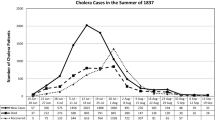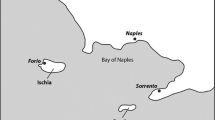Abstract
Introduction
Dr. Nathaniel Alcock in his book A treatise on cholera described 22 cases of cholera that he treated in 1832. Blood-letting, either by leeches or venesection, was an essential part of the treatment.
Rationale
The belief was that reducing the blood volume would relieve stress on the heart and lungs allowing for better function. The receipts of the Townsend Street Cholera Hospital where Dr. Alcock worked show how extensive the practice was. Outside Dublin, local Boards of Health dealt with the cholera epidemic. Various public measures such as street cleaning and removal of patients to temporary hospitals were undertaken and various cures were tried.
Outcome
The overall mortality rate from cholera in Ireland during the epidemic was 38 %, but in some areas much higher.
Conclusion
Even as cholera was spreading in the 1830s, a number of doctors were showing that intravenous fluids could dramatically alter the course of the disease. Unfortunately, their work was ignored and blood-letting continued to be a major component of the treatment of cholera for another 55 years.
Similar content being viewed by others
References
“cholera, n.” (2013) OED Online. March 2013. Oxford University Press, Oxford, http://www.oed.com.proxy.lib.ul.ie/view/Entry/32162?redirectedFrom=cholera+ (Accessed May 12, 2013)
Report of the commissioners appointed to take the census of Ireland for the year 1841. H.C. 1843 (504), vol 24, pp 624–625
Evan RT (1988) Epidemics and revolutions, cholera in nineteenth century Europe. Past Present 120:123–146
Alcock N (1849) A treatise on cholera, John Churchill, London
Annesley J (1825) A treatise on the epidemic cholera of the east, statistical and topographical reports of the disease in the different divisions of the army under the Madras presidency; embracing also the annual rate of mortality &c of European troops and practical observations on the effects of calomel on the alimentary canal and on the diseases most prevalent in India, Moyes, London
Annesley PV, Sir James H (1774–1847). Plarr’s Lives of the Fellows Online. Available at: http://livesonline.rcseng.ac.uk/biogs/E000411b.htm
Ainslie W (1826) Materia Indica or some account of those articles which are employed by the Hondoos and other eastern nations in their medicine, arts and agriculture comprising also formulae with practical observations names of diseases in various eastern languages and a copious list of oriental books immediately connected with general science, vol 1. Longman, London
Board of Health Ireland (1834) A return of the receipts and expenditure of the Central Board of Health; and of the General Board of Health for the city of Dublin, H.C. 447(51):1–28
Savage RB (1949) Catherine McAuley, the first Sister of Mercy, Gill & Son, Dublin
The Freeman’s Journal 15 Nov 1833
The Freeman’s Journal 3 May 1832
O’Brien G (1999) State intervention and medical relief of the poor. In: Malcolm E, Jones G (eds) Medicine, disease and the state in Ireland 1650–1940. Cork University Press, Cork, pp 195–207
O’Neill TP (1973) Fever and public health in pre-famine Ireland. J Royal Soc Antiquaries Irel 53:1–34
Hospitals (Ireland) Act, 1818
Nicholls G (1856) A history of the Irish poor law, John Murray, London
Osborne J (1833) Observations on cholera as it appeared at Castlebar, County of Mayo. Lond Med Gazette being a weekly journal of medicine and the collateral sciences 11:143–147
McGrath M. (ed.) Cinnlae Amhlaoibh Uí Shúileabháin. (1936–7) vol 3. Irish Texts Society, London
Tipperary Free Press, 28 July 1832
Hansard’s parliamentary debates, third series, (1830–1891) London, Hansard, 23 p c.753
Fenning H (2003) The cholera epidemic in Ireland, 1832–3: priests, ministers, doctors. Archivium Hibernicum 57:77–125
MacGillivray N (2009) Dr. Thomas Latta: the father of intravenous infusion therapy. J Infect Prev 10(supplement 1):S3–S6
Editorial (1832) The cases of cholera successfully treated by large aqueous injections, The Lancet ii p 286
Johnson G (1855) On epidemic diarrhoea and cholera: their pathology and treatment: With a record of cases. JW Parker and son, London, pp 112–114
Louis PCA (1828) Recherche sur les effets de la saignée dans plusieurs maladies inflammatoires. Arch Gen Med 21:321–336
Matthews JR (1995) Quantification and the quest for medical certainty, Princeton University Press, Princeton
Conflict of interest
None.




